People
Agrippa Wells
1738-1809
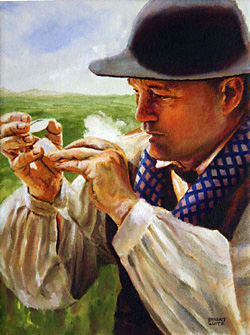
Agrippa Wells
© 2008 Bryant White
Prologue
Agrippa Wells was born to Thomas and Sarah Hawks Wells in 1738. He was the sixth of eight children who survived to adulthood. The family lived along the Common in the middle of Deerfield, a small town strategically located along the banks of the Deerfield River in the fertile Connecticut River Valley. Even as a young boy, Agrippa knew of wars and the violence that accompanied them. When Agrippa was eight years old, four Deerfield residents died in the last Native American raid on the town. In a time of ongoing conflict with Native peoples and England's traditional enemy, France, it is not surprising that Agrippa would become a soldier, as well as a blacksmith. (1)
A Fighting Man
In 1757, at the age of 19, Agrippa was a member of Rogers' Rangers, fighting in the French and Indian, or Seven Years, War. Agrippa's military service was not unusual; many young Massachusetts men sought adventure and money by joining the militia. These provincial units played an important role in Britain's ongoing contest with France for control of the North American continent. Agrippa's service with Rogers' Rangers was less typical, however. The Rangers, commanded by the charismatic Captain Robert Rogers, were an independent company of Provincial Irregulars renowned for their bravery, resilience, and effectiveness. They were scouts and skirmishers so adept at fighting in wooded and mountainous terrain that they were considered to be England's primary scouting unit in the 1750s. (2)
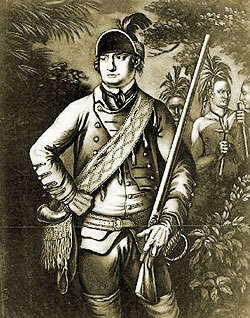
Agrippa Wells served under Captain Rogers in Rogers' Rangers, an elite company of irregulars formed during the French and Indian War, also known as the Seven Years War.
Mezzotint of Major Robert Rogers, by Thomas Hart, engraved in London in 1776.
Courtesy Fort Ticonderoga Museum, Ticonderoga, NY
In June of 1757, Agrippa was taken captive by Native Americans while scouting around Sabbath Day Point at the base of Lake George in New York. He was taken to Canada and forced to run the gauntlet. The gauntlet was a technique Eastern Woodland Native Americans used to test the mettle of their captives. The prisoner would be forced to run between two facing lines of Native people, all brandishing sticks and clubs, or throwing stones. How a captive behaved while running through this gauntlet was closely observed. Cowards were not worth adoption and were sometimes slain. Below is a description of running the gauntlet written by Colonel James Smith, who was a Pennsylvanian taken captive by the Delaware Indians in 1755:
"On approaching the fort, through large numbers of naked, painted savages who were formed into two long ranks, I was obliged to run the gauntlet. I was told that if I ran quick it would be so much the better, as they would quit when I got to the end of the ranks. I started in the race with all the vigor and resolution I was capable of exerting. When I had got near the end of the lines I was struck to the ground with a stick or the handle of a tomahawk.
"On recovering my senses I endeavored to renew the race, but as I rose some one threw sand in my eyes, which blinded me so that I could not see where to run. They continued beating me until I was insensible; but before I lost consciousness I remember wishing they would strike the final blow, for I thought they intended killing me, and that they were too long about it. I was sent to the hospital, and carefully tended by a French doctor, and recovered quicker than I expected.
"I asked a Delaware Indian who could speak some English, if I had done anything to offend them which caused them to beat me so unmercifully? 'No,''he replied, 'it was only an old custom the Indians had, and was like "how do you do?" After this,' said he, 'you will be well used.'' (3)
Agrippa was reported to have successfully run his gauntlet and delivered a furious kick to a woman near the end of the line, proving he was certainly no coward, and gaining the respect of his captors. He was eventually exchanged and sent first to France, then England, and eventually home to Massachusetts, where he settled to farm in Shelburne, a town about 13 miles northwest of Deerfield. Agrippa served as a selectman and commanded a local company of militia made up of men from Shelburne, Greenfield and Bernardston. When he was 23 years old, he married Mehitable Smead of Greenfield in 1761. Their first child, Mehitable, was born in 1762. By the outbreak of the Revolutionary War, the Wells family had experienced the birth of seven children and the death of two. Twice Agrippa tried for a namesake. The first Agrippa, born in 1764, drowned in 1772 at the age of eight. The second Agrippa was baptized in 1774, but he also died in childhood. (4)
As relations between England and her North American colonies deteriorated through the 1760s and '70s, local militia companies began drilling and bracing for armed confrontation. A few years before war broke out, Agrippa moved his family to Greenfield, where his military experience and his status as a respected member of the community made him an obvious choice to lead one of these companies. When news arrived of the first shots at Lexington in 1775, Captain Agrippa Wells led 50 men from the surrounding towns of Greenfield, Bernardston and Deerfield to Cambridge. He received a Captain's commission in May, 1775 and served for three months at Fort Ticonderoga in 1776. (5)
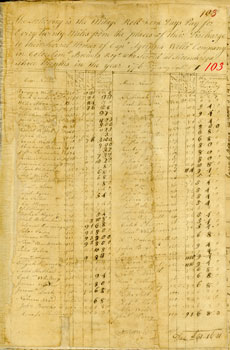
This muster roll records Agrippa Wells' service as a Captain in the Massachusetts militia.
More info
Courtesy Capital Rotunda, Washington DC
Wells' militia company would also participate in the Saratoga campaign of 1777, where Agrippa and his men witnessed the historic surrender of General John Burgoyne and his 5,000 man army.
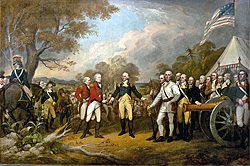
Like many other men from western Massachusetts, Agrippa Wells participated in the Saratoga campaign. In 1815, American artist John Trumbull painted this famous scene of the surrender of General John Burgoyne to General Horatio Gates and the American Army.
Courtesy Capitol Rotunda, US Government, Washington DC
After the war, Agrippa moved his family to Bernardston and then to Leyden, two Massachusetts towns bordering Vermont. His family continued to grow, adding four more children, but losing a seven-year-old daughter in 1778, and an infant born in 1777. Of Agrippa and Mehitable's 11 children, only 7 would survive to adulthood. (6)
The Regulation
Like other Americans, Agrippa and his neighbors welcomed the end of the war. All too soon, hopes for peace and prosperity dissolved in the economic and political unrest of the 1780s. This time, the trouble was not an invading army, but thousands of Massachusetts men who could not agree on how to preserve and nurture the freedoms the Revolution promised. On the one hand were the men who called themselves "Regulators." They believed they were protecting the freedom the Revolution had promised from what they saw as the betrayal of those freedoms by an unresponsive and aristocratic Massachusetts government. They were especially outraged by high taxes and a costly court system they thought unfairly discriminated against cash-poor citizens. In the fall and winter of 1786, armed groups of Regulators began closing Massachusetts courts across the Commonwealth.
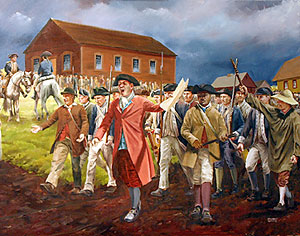
Agrippa Wells joined the thousands of men who came to Springfield to prevent the session of the Supreme Judicial Court from convening in September, 1786. Detail from Petition and Protest
© 2008 Bryant White
Meanwhile, the government and its allies condemned these activities as traitorous and labeled the people involved "insurgents." These citizens, who called themselves the "Friends of Government," argued that they were saving the Revolution from sliding into chaos at the hands of a desperate mob who seemed determined to abolish all debts and destroy sacred contract obligations. As the crisis deepened, the Massachusetts government called upon Captain Agrippa Wells to muster a company of militia to protect the Supreme Judicial Court at Springfield in September, 1786.
Among the Regulators heading to Springfield to stop the court were men Agrippa and his militia company knew well; many were fellow veterans. Wells also had witnessed first-hand the economic distresses of the severe post-war recession. As they marched to protect the Court, Captain Wells and the Leyden, Colrain and Bernardston men under his command, made a startling decision. Instead of protecting the Court, Agrippa and his men joined the ranks of the Regulators, forcing the Court to adjourn without conducting any business. (7)
Once he made his decision to join the Regulator cause, Captain "Grip" did not look back. He and his men were in the front ranks of the 1,400 men under Captain Shays and Captain Parsons who marched on the United States Arsenal at Springfield on January 25, 1786. When the Arsenal artillery opened fire, Wells did not flinch, although his company took the brunt of the combined cannon and howitzer fire. When the ranks of the inexperienced men behind his veterans broke and fled, Agrippa refused to join them. When his own men gave up and ran, he stood alone, cursing their cowardice. Only as he realized the day was hopelessly lost did he reluctantly retreat.
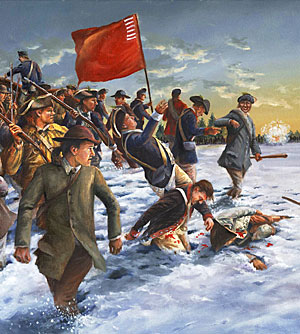
Even as the men in his company fell before the artillery fire from the Arsenal cannon, Agrippa refused to yield. Detail from Bloody Encounter - Regulators
© 2008 Bryant White
In the dark days that followed, thousands of men came forward to take the oath of allegiance the government offered in return for a conditional pardon. Men who took the oath were barred from voting, teaching school or keeping a tavern for three years. Those who owned firearms were ordered to surrender them. (8)
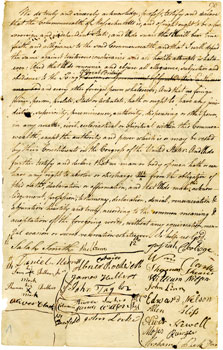
These men from Hampshire County were among the thousands of former Regulators who came forward to take an oath of allegiance to the state of Massachusetts. Agrippa Wells' name does not appear among them.
More info
Courtesy, Massachusetts Archives, Boston, MA
Agrippa apparently never took the prescribed oath, although he did turn in his gun to fellow militia veteran Colonel Joseph Stebbins, who had sided early and firmly with the government.
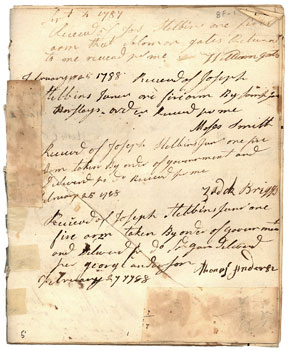
Many Revolutionary War veterans took part in Shays' Rebellion—on both sides. In 1787, Agrippa Wells surrendered his musket to another Revolutionary War veteran, Joseph Stebbins of Deerfield.
More info
Courtesy Pocumtuck Valley Memorial Association, Deerfield, MA
As 1787 wore on, the harsh, retaliatory actions of the government gave way to the milder, more conciliatory policies of the newly elected and popular Governor John Hancock. Like other men who had actively participated in what came to be called "Shays' Rebellion" after one of its more well-known leaders, Agrippa both voted and held office regularly. (9)
In addition to serving as a selectman for Bernardston in 1787, Agrippa was chosen by Bernardston as the town's delegate to the Massachusetts Convention, called to vote on whether or not to ratify the new proposed United States Constitution. His town gave him the following instructions:
Sr the Town of Bernardston & district of Leyden having made Choice of you to represent them in the Convention, proposed to be holden, at Boston, on the Second, Wednesday of January next, for the purpose of Considering, and acting on the Federal Convention [i.e., Constitution], lately proposed by the General Convention at Philadelphia have by this Choice, sufficiently, Testifyed their Confidence, in your ability & integrity to represent them in the proposed Convention but at the same time think they have a right, to give you instructions, to regulate your Conduct in your abovesaid Capacity and do instruct you not totally, to reject the abovesaid Constitution, being of the opinion that by proper amendments, it may be adopted to secure our liberties, and answer the Design of the general Union, and that with regard to those Amendments, you should pay particular attention, to those Objections made against asd. [i.e., aforesaid] Constitution, by Mr. Elbridge Gerry, and by the Minority of the Assembly of Pensalvania, as lately published in the Springfield & Northampton papers. (10)
Despite these instructions, Agrippa Wells was among the 168 delegates who voted against adopting the proposed federal Constitution in February, 1788. Since the Convention was charged with either accepting completely or rejecting entirely the proposed government, Agrippa may have felt that the lack of opportunity to add important amendments prevented him from endorsing it. Or, perhaps he felt, as did the Hon. Mr. White of Norton, Massachusetts, that despite adding possible amendments, "it would endanger the liberties of his country." (11)
Like Wells, most of the other delegates from Hampshire County voted against ratifying the Constitution. However, the general consensus amongst the nay voters seemed to be that, given the recent turmoil of Shays' Rebellion, it was prudent to avoid further unrest and bloodshed and strive for peace, despite differing opinions on the best plan of governing the United States. In the end, Agrippa agreed with Mr. White's sentiment that, "yet as a majority had seen fit to adopt it, he should use his utmost exertions to induce his constituents to live in peace under, and cheerfully submit to it." (12)

The vote to ratify the proposed United States Constitution passed by only 19 votes, but delegates like Agrippa Wells who cast nay votes, pledged to support the decision of the ratifying convention.
More info
Courtesy Pocumtuck Valley Memorial Association, Deerfield, MA
Epilogue
In 1793, Agrippa and Mehitable moved from Bernardston to Greenfield. Their surviving children were, by then, grown and gone. Mehitable died in 1801 at the age of 60, and Agrippa died in 1809 at the age of 71. (13) Known as "Captain Grip" by those who knew him and served under him, Agrippa Wells had proven to be a brave, effective and respected leader, well deserving of the roles and titles granted to him.
About This Narrative
Note: All narratives about people are, to the extent possible, based on primary and secondary historical sources.
See Further Reading for a list of sources used in creating this narrative. For a discussion of issues related to telling people's stories on the site, see: Bringing History to Life: The People of Shays' Rebellion
| Print | Top of Page